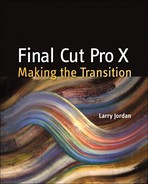Welcome
Final Cut Pro X was born amid controversy.
And that is a shame, because if you ignore the trauma surrounding its birth, there’s a lot of exciting new technology, power, and ease of use hiding under the hood.
That got me thinking about writing this book.
When you decide to move to Final Cut Pro X, you are also deciding to make a transition—a transition from the system you were using to this new system. For some, that transition is easy. For others, it’s difficult. In all cases, it helps to have a guide to show you the way.
That’s the purpose of this book—to ease your transition into Final Cut Pro X.
Who This Book Is For
Knowledge is knowing “how” to do something. Wisdom is knowing “why.” It is my hope that this book contains both. This book is for anyone interested in editing video using Final Cut Pro X.
This book is designed to help you learn the new software from beginning to end; I’ll start with getting you and your system ready and wrap up with exporting.
Best of all, you don’t need to be an editing genius or technical geek to understand this book. Some editing experience is expected (this is a “transition” book, after all) but the first two chapters help you get organized and explain the basics so you can get started immediately. Then, once you’re up and running with the new software, I’ll spend the rest of the book walking you through the whole application in detail so you can make it fly.
In fact, if you browse around the book, you’ll discover lots of little tips and tricks scattered throughout. I love these—there’s nothing like a good shortcut to brighten my day!
What This Book Covers
When I first saw Final Cut Pro X, my initial thought was, “This is way too different for me to learn.” This was chiefly because I knew earlier versions of Final Cut so well, and this version appeared to be so different. However, after spending time studying it and writing this book, I realized that there is a lot of power under the hood, and learning this version of Final Cut is a lot easier if you get started the right way. That’s my goal: I want to save you hours of figuring it out on your own so you can become productive immediately.
I’ve been writing about Final Cut Studio for ten years in books, magazines, newsletters, and the Web. My free monthly newsletter—now in its seventh year—is the oldest and most widely read publication on Final Cut Pro in the world (www.larryjordan.biz/newsletter). It reaches tens of thousands of readers worldwide each month.
I got my start in this industry more than 35 years ago as a producer and director. I’ve worked in local television and the networks, principally doing live broadcasts, drama, and special events. I’m a member of the Directors Guild of America and the Producers Guild of America. This is the sixth book I’ve written on editing software (five on Final Cut Pro and one on Adobe Production Premium). I’m an Apple Certified trainer in digital media and travel the world doing seminars and training, helping editors become better at their craft.
I was one of the few people outside of Apple to see a preview of this new version of Final Cut several months before it was released. I realized then that this software would revolutionize the way we think about video editing.
In talking with hundreds of editors after FCP X was launched, I realized that a lot of them are looking for guidance in how to make the transition to the new software. Gone were many of the terms and functions they had become used to; they’ve been replaced with a new interface and a new way of thinking about editing.
This transition to Final Cut Pro X is difficult for many Final Cut Pro 7 editors because there is a lot to “unlearn.” On the other hand, after working with this awhile, much of the new interface becomes intuitive, though it’s different from what they’ve used before.
Video editing is part of the process of visual storytelling. Editing a film starts with planning, as you’ll learn in Chapter 1. This process flows from planning to production to editing and final delivery. Final Cut Pro X is one stop along that continuum. It is at the core of the editing/postproduction process.
I’m a firm believer that, as a teacher, I need to do more than simply tell you which buttons to push. I need to explain the “why” as well as the “how.” I need to do more than tell you that a hammer is used to pound nails. I need to illustrate how you use that hammer to build a house, when to use other tools, and show how that hammer fits into the whole process of house building.
In other words, one of my goals is to put Final Cut Pro X in the context of the larger world of visual storytelling and not simply say, “Click here and, poof, magic happens!” Knowing where to click is good. Knowing why to click is even better.
Effects Cookbooks Available for Download
One of the challenges in writing a book is that it is easy to run out of pages before I run out of ideas. That’s the case here.
I have created two additional chapters—the Visual Effects Cookbook and the Audio Effects Cookbook—which are available in PDF form as a free download, once you register your book at http://www.peachpit.com/register.
These two chapters provide step-by-step instructions on how to create almost two dozen clip effects—from simple picture-in-picture techniques to sophisticated audio filters and processing.
This is just a partial list of what’s available in these two chapters:
• Adding, adjusting, disabling, resetting, and removing clip effects
• Animating a blur and adding title text
• Creating a vignette
• Adding lighting effects
• Creating a color mask
• Matching audio between clips
• Creating an audio effect
• Warming up a voice
• Using the Limiter effect to boost and smooth out audio levels
There are a lot of cool techniques and insider tips you can use in your own effects. Register your book and download your copies of these useful bonus chapters today.
Where the Images Came From
One of the hardest challenges in creating a book is finding the right media to use to illustrate the concepts I am trying to teach. This makes me especially grateful to the following people for allowing me to use their images:
For the interview footage of Dr. Vint Cerf, I want to thank both Dr. Cerf and Alcatel/Lucent. This interview was recorded in 2004 for Alcatel/Lucent as Dr. Cerf was getting ready to deliver a speech at Van Nuys High School, in Van Nuys, California, about the importance of education and staying in school. Visit the Alcatel/Lucent website at www.alcatel-lucent.com.
Note: How I Do My Screen Captures
While the Mac has a built-in screen capture utility (Shift+Command+3 captures the entire screen and Shift+Command+4 displays a cursor so you can capture a portion of the screen), I prefer the flexibility and options of Ambrosia Software’s SnapZ Pro X. All the screenshots in this book were captured with SnapZ Pro X.
I’m grateful to Pond5 for sharing some of their vast collection of royalty-free images. This is but a small sampling of what is available at www.pond5.com.
The dramatic footage in Chapter 6 comes from John Putch and his movie Route 30, Too! John has graciously shared a number of scenes from his film to help me illustrate the challenges of editing dramatic work. Learn more at www.route30trilogy.com.
Since I am a huge train fan, I want to thank Fran and Miles Hale of Model Railroad Builders for the stunning model train layout video. Frankly, I was having so much fun watching the trains roll past, I almost didn’t get this book written. Visit their website at www.franandmileshale.com.
I’ve been using snowboarding footage from the great folks at Standard Films for all of my books. In fact, it’s the same footage. Don’t mess with success! I’m grateful to Mike Hatchett for allowing me to continue to use this footage. Visit their website at www.standardfilms.com.
I am also grateful for clips from Michael Shaw, Resmine Atis, and Tom Centeno.
Finally, I want to thank SmartSound Software, Inc., for access to their music library. I’ve been a fan and user of SmartSound since 1997 and happily recommend them to anyone looking to build a library of great production music. Learn more at www.smartsound.com.
Special People to Thank
Writing a book is the effort of one person. Publishing a book takes a team.
I’d like to thank Karyn Johnson and the folks at Peachpit Press for inviting me to write this book. This is the fifth book I’ve done for Peachpit, and they make the process easy (well, as easy as writing a book can be, which is rarely easy).
An incredible team of very talented folks here at my company, Larry Jordan & Associates, Inc., including Debbie Price, Laura Peters, Mina Qubaisi, and Cirina Catania for keeping things running when I was busy writing. I count on them more than I can possibly express. Patrick Saxon for his help with some of the initial drafts and Noë Gold for his in-depth review of all the chapters.
Jacqueline Aaron and Kim Wimpsett, two copy editors who strove mightily to make sure my grammar, syntax, and punctuation were coherent. To an amazing compositor, Danielle Foster, who continually delighted me with her ability to balance great design with squeezing as many words on the page as would beautifully fit.
Katie Fredeen for the illustrations (below and in Chapter 1). I only wish there was room to print more of them.
A team of experts to help me better understand the technology, including Philip Hodgetts, Greg Clark, and hundreds of editors who took the time to e-mail me their questions and thoughts about the new software.
Finally, special thanks go to members of the Apple Final Cut Pro team: Richard Townhill, Steve Bayes, Luke Tristam, and Jud Coplan for answering innumerable questions and helping me better understand this new application.
Still, I hasten to add that though I’ve had a lot of help, the responsibility of writing this book is mine, as are any (ideally few) mistakes that might still be lurking inside.
One Last Thought
Producing good-quality, interesting video is not for the faint of heart. The reason we got into this bizarre, competitive, deadline-driven business was that we like to tell stories. Visual stories. Stories with passion, movement, and characters people want to care about.

Final Cut Pro X is a tool that helps us tell those stories—faster, better, and more easily than any other editing software. It has been a fascinating process learning this software and sharing it with you.
Whether you edit video as a hobby or as a profession, powerful stories create profound results. Video can change the world—for good or bad. It can increase understanding or build barriers. Final Cut Pro X gives us the power, but how we use it is up to us.
Thanks, and edit well.
